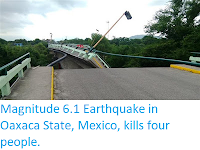The United States Geological Survey
recorded a Magnitude 7.4 Earthquake at a depth of 26.3 km, approximately 12 km to the southeast of Santa María Zapotitlán in Oaxaca
State,
Mexico, slightly before 10.30 am local time (slightly before 3.30 pm GMT) on
Tuesday 23 June 2020. This even was felt across much of
southern Mexico, and well as in Guatemala, Belize and Honduras, and there are reports of damage to a number of buildings, as well as at least one fatality.
Damage to a building in Oaxaca State, Mexico, following a Magnitude 7.4 Earthquake on 7.4 June 2020. Luis Alberto Cruz Hernandez/AP.
Mexico is located on the southernmost part of the North American Plate.
To the south, along the Middle American Trench, which lies off the
southern coast off Mexico, the Cocos Plate is being subducted under the
North American Plate, passing under southern Mexico as it sinks into the
Earth. This is not a smooth process, and the plates frequently stick
together then break apart as the pressure builds up, causing Earthquakes
on the process.
The approximate location of the 23 June 2020 Oaxaca Earthquake. USGS.
The Cocos Plate is thought to have formed about 23 million years ago,
when the Farallon Plate, an ancient tectonic plate underlying the East
Pacific, split in two, forming the Cocos Plate to the north and the
Nazca Plate to the south. Then, roughly 10 million years ago, the
northwesternmost part of the Cocos Plate split of to form the Rivera
Plate, south of Beja California.
In a paper published in the Journal of Geophysical Research, in 2012, a team led by Igor Stubailo of the Department of Earth and Space Sciences at the University of California Los Angeles, published a model of the subduction zone beneath Mexico using data from seismic monitoring stations belonging to the Mesoamerican Seismic Experiment, the Network of Autonomously Recording Seismographs, the USArray, Mapping the Rivera Subduction Zone and the Mexican Servicio Sismologico Nacional.
The seismic monitoring stations were able to monitor not just
Earthquakes in Mexico, but also Earthquakes in other parts of the world,
monitoring the rate at which compression waves from these quakes moved
through the rocks beneath Mexico, and how the structure of the rocks
altered the movement of these waves.
Based upon the results from these monitoring stations, Stubailo et al.
came to the conclusion that the Cocos Plate was split into two beneath
Mexico, and that the two plates are subducting at different angles, one
steep and one shallow. Since the rate at which a plate melts reflects
its depth within the Earth, the steeper angled plate melts much closer
to the subduction zone than the shallower angled plate, splitting the
Trans-Mexican Volcanic Belt into sections above the different segments
of the Cocos Plate, and causing it to apparently curve away from the
subduction zone.
Top
the new model of the Cocos Plate beneath Mexico, split into two
sections (A & B) subducting at differing angles. (C) Represents the
Rivera Plate, subducting at a steeper angle than either section of the
Cocos Plate. The Split between the two has been named the Orozco
Fracture Zone (OFZ) which is shown extended across the Cocos Plate; in
theory this might in future split the Cocos Plate into two segments
(though not on any human timescale). Bottom Left, the position of the
segments on a map of Mexico. Darker area is the Trans-Mexican
Volcanic Belt, orange circles are volcanoes, brown triangles are
seismic monitoring stations, yellow stars are major cities. Bottom
Right, an alternative model showing the subducting plate twisted but not
split. This did not fit the data. Stubailo et al. (2012).
Witness
accounts of Earthquakes can help geologists to understand these events,
and the structures that cause them. The international non-profit
organisation Earthquake Report is interested in hearing from people who may have felt this event; if you felt this quake then you can report it to Earthquake Report here.
See also...
Follow Sciency Thoughts on Facebook.










